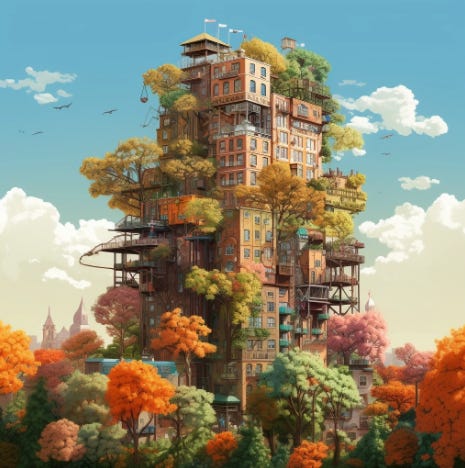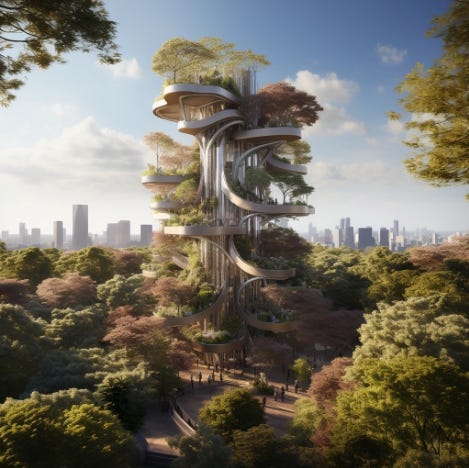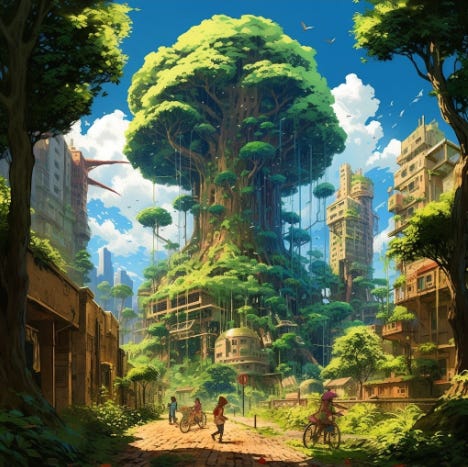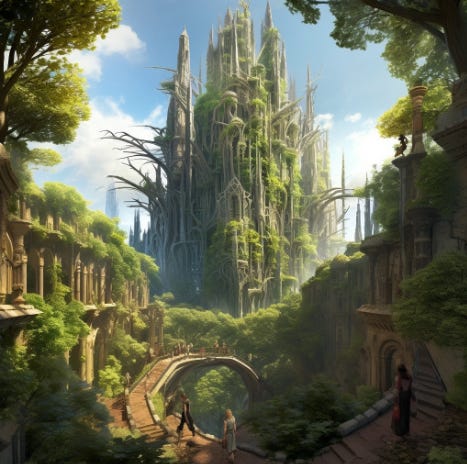The 18 Groves
I had the real pleasure and life-changing opportunity to participate in an exploratory research fellowship interested in cross-pollinating between social work and foresight. Our group has now transitioned into the Social Work Futures Lab and is working to design and host a conference to share our findings with the social work profession at large. As a result, I’ve been doing a lot of reflection about the tools I learned and the ways of thinking I was exposed to.
A central practice of futures work is signal-gathering. Many foresight scholars have explained this practice more elegantly than I ever will, but the brute force explanation boils down to noticing and collecting bits of news and trends. Then you introduce fantasy into the process. As an example: if those bits of news and trends all evolve into their fullest form, and if the circumstances of the world-at-large lead to total collapse (or growth, or transformation, etc.) in 20 years, what does that particular future look like? It’s an exercise in imagination. Foresight practitioners call it scenario-building.
The Lab recently had a series of consultations with the futurist Jane McGonigal to help guide our design of attendee experience at the conference. Using her Urgent Optimists activities, we played with “Monuments from the Future.” We each considered an issue we care deeply about and then imagined, using a 10-20 year horizon, a future where that issue has been fully resolved. Then we envisioned a public monument that had been created in that future to commemorate that breakthrough.
I envisioned a warm, towering monument to nature in a tree-lined city. The scenario of this monument incorporates necessary collapse to make room for eventual transformation.
THE STORY OF THE GROVES
By the end of the 2020s, massive civil unrest - stoked by cascading crises, nationalism, and widespread rationing of water and energy - rose to its breaking point. The planet's biosphere was collapsing under failed climate initiatives, empty promises to pay carbon taxes, and a demand for natural resources that outpaced the earth's ability to regenerate ten-fold. This period, now known as the Great Dispossession, saw loss of life and welfare on a scale never before experienced in human history.
By 2033, it is estimated that over 85%* of the global population had been moderately to severely impacted by climate disaster. *This number is likely higher, but data collection and preservation during this period frequently deprioritized the Global South, creating a notable data gap.
These impacts ranged from the acute loss of home and primary community; the death or assumed death of a loved one; the trauma of forced climate migration and the subsequent discrimination that was almost universally directed at refugees; the hellish conditions of migrant camps and relocation zones; countless traumatic separations of family members in the poorly-regulated and inhumane Climate Migrant Priority Program (CliPri) and similar location-matching systems; rampant xenophobia and mistrust; total property destruction or abandonment, both residential and commercial; extreme water rationing mandates that limited millions of households to 84 gallons per week - approximately 3 gallons per person per day; energy scarcity and throttling as rolling blackouts from high power usage during extreme heat events (EHEs) forced power companies to begin metering residential usage, which led to heat stroke epidemics; as well as varying degrees of food scarcity.
Beyond the individual experiences of calamity and chaos, the biosphere was crumbling. Widespread collapse of insect populations created cascading wildlife "die-off" events; millions of acres of old-growth habitat were destroyed as a direct result of deforestation and last-ditch efforts to mine and drill before punitive regulation deadlines would go into effect; ocean warming led to a collapse of fishing industries as acidification and nutrient shifts caused devastating marine imbalance; global air quality plummeted so severely that household air purifiers and monitors were deemed as necessary as clean water and fire alarms - mask-wearing became commonplace outdoors; waste and plastics problems were so pervasive that major cities across the planet resorted to "trash burn sectors" - locations that frequently were found to be in close proximity to impoverished communities; and 91% of all remaining glacial coverage was lost.
Fundamental, global change was needed - and shifting demographics became the deciding factor. As Gen Z and Gen Alpha flooded political office at all levels, and Gen II became known as “the planet’s voice,” a change in long-held values was finally able to break through.
Civil unrest and climate disaster persisted for the entirety of the Two-Thirties, but extreme mitigation policies and equitable resource management slowly helped stem the tide of immediate disasters and organize response work. At the dawn of the new decade, an international summit was held in Nairobi. The Planetary Health Alliance Coalition (P-HAC) was formed as part of the summit's commitment to pursuing the immediate redesign of human infrastructure and its function. The Natural Space and Species Endeavor (NSSE), a branch of P-HAC, now helms the pan-global effort to equitably re-seed, re-green, and re-orient our major cities. The Groves were designed to meet these goals and are the primary, ongoing project of the NSSE.
Collaborative, participatory, and intentional, the Groves are a functional symbol of humanity's unified commitment to work with, rather than against, our biosphere. Planting began in 18 test cities around the world in 2044. These cities led the way for sustainable and cooperative restructuring of everything from municipal government and public transportation to zoning, resource stewardship, and equitable green space formation. While they all have their own unique design, each Grove serves its urban communities to this day as a gathering place and refuge for all creatures. A series of 8 identical plaques unify the Groves in common purpose, commitment, and memory.
PLAQUES
Visitors to each Grove may choose to follow its central, winding path, along which a series of 8 plaques have been erected.
For Earth. Our verdant, singular home in a vast ocean of stars.
Our growth and expansion has been built on the materials of our planet, its creatures, and our own bodies.
Now, we offer change as our greatest gift. Growing with and within, rather than without.
We honor, mourn, and commit to the unfairly felled: that the value of life will forever more be divorced from capital and coin.
We are neither above nor apart from the natural world.
We are nature. It is in our bones, our art, our homes, and our futures.
No matter what distant stars may come, we are tethered to this planet - this Earth, our Earth.
This grove is a community project of the Natural Space and Species Endeavor (NSSE). Planting began in 2044.









Signals that inspired this scenario
The importance of trees in human habitat design: Reddit thread, 2023
Moving toward design that considers human and non-human spaces: Stead & Coulton, 2022
Policymaking from youth perspectives: UN Web TV, 2022
The expansive boundaries of bio-futurism: Synergetic Press, 2015
Heat-waves and high-risk areas: Thompson, et al., 2023
Mutual aid as a response to crisis: Littman, et al., 2023
Creating sustainable, affordable housing in climate crisis: Tamarack webinar, 2023
Politics & policy for climate response: YPCCC, 2023
Documenting glacier loss: The Last Glacier, ongoing


